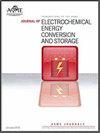Preparation and characterization of Red Mud modified Chitosan-PVA composite membrane for direct methanol fuel cell
IF 1.9
4区 工程技术
Q3 ELECTROCHEMISTRY
Journal of Electrochemical Energy Conversion and Storage
Pub Date : 2022-09-21
DOI:10.1115/1.4055693
引用次数: 3
Abstract
A novel cost effective Chitosan-PVA-Red Mud (RM) hybrid membranes are developed and their morphological and physiochemical properties are studied. The addition of RM enhanced IEC and bound water content in a composite membranes. The hydroxyl groups are consumed due to the interaction with silica oxides and depleted the crystalline phase of the composites. The tensile strength and modulus of the composite membranes were reduced. The addition of RM improves the thermal stability of the composite membrane and shifts the degradation process to a higher temperature. The RM nanoparticles depleted the hooping sites for methanol transport in the composite membrane and the permeability value reported in the modified membrane was one order lower than the Nafion (N117) membrane. The proton conductivity of the composite membranes are obtained by fitting the EIS data in an equivalent circuit model. The composite membrane provides higher proton conductivity at reduced relative humidity conditions and the proton transport was governed by Grotthus mechanism. The modified membrane provides the maximum power density of 44mW/cm2 at a current density of 140mA/cm2. The durability test was conducted at a current density of 0.15 Acm2 and 70°C for 144h to evaluate fuel cell performance and voltage decay. The durability study confirms that the modified membrane provides higher cell stability with marginal drop in cell voltage (1.76%). The reduction of methanol cross-over and the enhancement of membrane selectivity increases power density of the direct methanol fuel cell.直接甲醇燃料电池用赤泥改性壳聚糖-聚乙烯醇复合膜的制备与表征
研制了一种经济高效的壳聚糖-聚乙烯醇-赤泥(RM)杂化膜,并对其形态和理化性质进行了研究。RM的加入提高了复合膜中的IEC和结合水含量。羟基由于与二氧化硅氧化物的相互作用而被消耗,并耗尽了复合材料的结晶相。复合膜的拉伸强度和模量降低。RM的加入提高了复合膜的热稳定性,并将降解过程转移到更高的温度。RM纳米颗粒耗尽了复合膜中甲醇传输的环位点,并且在改性膜中报道的渗透值比Nafion(N117)膜低一个数量级。通过在等效电路模型中拟合EIS数据,获得了复合膜的质子电导率。复合膜在降低的相对湿度条件下提供更高的质子传导性,并且质子传输由Grotthus机制控制。改性膜在140mA/cm2的电流密度下提供44mW/cm2的最大功率密度。耐久性测试在0.15Acm2的电流密度和70°C下进行144小时,以评估燃料电池性能和电压衰减。耐久性研究证实,改性膜提供了更高的电池稳定性,电池电压略有下降(1.76%)。甲醇交叉的减少和膜选择性的提高提高了直接甲醇燃料电池的功率密度。
本文章由计算机程序翻译,如有差异,请以英文原文为准。
求助全文
约1分钟内获得全文
求助全文
来源期刊

Journal of Electrochemical Energy Conversion and Storage
Engineering-Mechanics of Materials
CiteScore
4.90
自引率
4.00%
发文量
69
期刊介绍:
The Journal of Electrochemical Energy Conversion and Storage focuses on processes, components, devices and systems that store and convert electrical and chemical energy. This journal publishes peer-reviewed archival scholarly articles, research papers, technical briefs, review articles, perspective articles, and special volumes. Specific areas of interest include electrochemical engineering, electrocatalysis, novel materials, analysis and design of components, devices, and systems, balance of plant, novel numerical and analytical simulations, advanced materials characterization, innovative material synthesis and manufacturing methods, thermal management, reliability, durability, and damage tolerance.
 求助内容:
求助内容: 应助结果提醒方式:
应助结果提醒方式:


